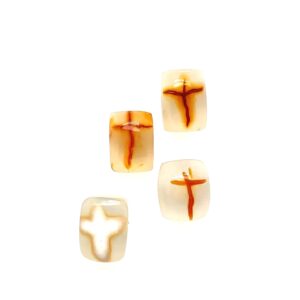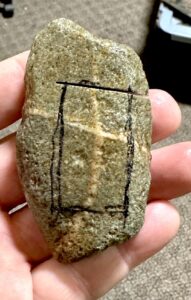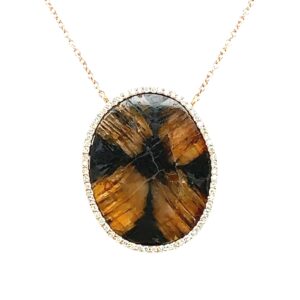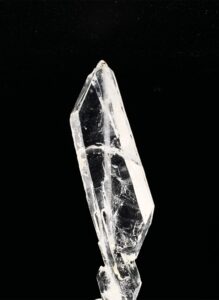By Jennifer Heebner, Editor in Chief
It was 30 years ago when jewelry designer Mark Loren spied his first Brazilian Andalusite gem featuring a natural cross formation. He was cruising through the Pueblo Gem & Mineral Show in Tucson, Ariz., when the jewelry designer and retailer from Mark Loren Designs in Fort Myers, Fla., saw a table of the material cut into slices. In this state, he could see some cross-shaped inclusions of carbon, which aren’t uncommon to see in some metamorphic rocks.

“I had never seen anything like it,” he says. “You can only look at so many Rubies, and this gave me a new palette to work with.”
This innocent little purchase put him on a path to acquiring many more natural cross-shape-included gemstones. To date, he’s owned upwards of 55 pieces, including a trio of Russian-origin Staurolite crosses in a mica-schist matrix. “Staurolite usually occurs in the X axis, so to have these right-angle alignments is rare,” he observes.

He’s had what he calls a “sweet pair” of Surabaya Agates with natural iron oxide crosses in them that he sold as ear pendants, though he still has about a dozen more. Loren has found clear Quartz with copper-color rutiles in cross shapes—including one that he framed in Diamonds and white gold—as well as clear Quartz with black Tourmaline cross inclusions. More Brazilian Andalusite or Chiastolite crystal slices with natural medieval cross-shape inclusions have been paired with golden Coral beads and rose gold and Diamonds. A lens-cut blue Topaz had a super subtle split in the shape of a cross—“It was hard to see,” he concedes—and he’s also picked up Turquoise with cross-shape veins.

He’s so obsessed that he’s talked to cutters about retaining natural cross formations in gems as they work. For sure, they’re special gifts to give, and not just for Christians.
“These are for anyone looking for a unique artistic gift, and most jewelers never see these, which are incredible natural works of art,” Loren explains. “Collecting these is a completely gemological pursuit, and some people don’t even mount them.”

One of his fave finds? An Arkansas Quartz crystal with long wispy cross inclusions sold to him in Tucson by a “cute girl who was burning incense and liked my aura,” he recollects. He paid just $7 for it.
Because they’re so rare to find, Loren prices them accordingly. “Try to find another one,” he challenges. “Part of what we do is education. We sell a lot of hearts and crosses and clients go wild for them because each is a one of a kind—likes God’s little fingerprint.”

And while this collection is clearly spiritually suggestive, Loren lacks any religiosity at all. “I’m the only agnostic Jew you’ll ever meet,” he says. “No matter your religious practice, you’ll recognize a cross—it’s a global, simple symbol that means different things to different people.”

This is proprietary content for AGTA and may not be reproduced.
